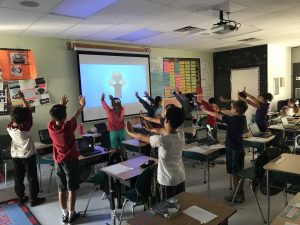Limit Screen Time
Limit daily screen time for kids and instead get them up, moving and spending quality time with family and friends!
Read More We know that limited screen time is best, but we also know that in a world with so many advancements in technology – screens are often a part of most people’s lives. Creating space for screen time means making the most of screen time – for learning, for mindfulness and movement, for connection and sometimes just play. Find ways to use screen time for good and think outside of the box to help children learn, move, think and connect with the click of a button.
We know that limited screen time is best, but we also know that in a world with so many advancements in technology – screens are often a part of most people’s lives. Creating space for screen time means making the most of screen time – for learning, for mindfulness and movement, for connection and sometimes just play. Find ways to use screen time for good and think outside of the box to help children learn, move, think and connect with the click of a button.
Access to online education tools have become an incredible resource for at-home and on-the-go learning. Not only do these tools provide children with opportunities to explore a wide range of subjects, they also support parents in developing confidence in the role they play in supporting the Whole Child. Utilize the wide range of online resources and use screen time for health and happiness to help children explore the world.
Technology has opened a world of opportunity for children and adults to practice mindfulness through resources like guided meditations, virtual yoga classes, and music streaming. Place the intention of mindfulness at the root of your screen time by listening to your favorite song and thinking about the meaning of the lyrics or practicing virtual yoga or meditation. Whatever the screen time activity may be, if you place the intention to be mindful and reflective behind the activity, you can help children develop skills in self-reflection, self-awareness, and begin to connect the mind and body.
Do you have a favorite type of movement? Whether you are a dancer, walker, yogi, or other type of mover and groover there are many ways to get moving with screen time. Online videos and tutorials for movement provide children with opportunities to find their favorite ways to move their bodies. Body movement is important because it gets our blood flowing and our minds working, therefore boosting our moods and abilities to cope with difficult situations.
Social interaction and communication are crucial to maintaining balanced social-emotional well-being. Luckily, we live in a world where we can communicate with a friend or family member just by the touch of a button. Use screen time to schedule calls or virtual hangouts with family members and friends.
At the end of the day, sometimes a little play time is all that is needed and if it’s with a screen – that’s okay. Set boundaries to limit screen time and invite children to be a part of the process. Make a schedule to hang on the refrigerator with screen time blocked for a small period of time or create your own “check out” system. Before hopping behind a screen, have children check out small devices or a “pass” to use larger ones and set a timer. Be clear on the rules that surround screen time to help kids feel empowered to take ownership on making responsible choices.
Activities such as these help children explore…
Self-Awareness and Responsible Decision Making: Helping children better understand healthy ways to use screen time increases their capacity to make constructive choices. Screen time engages many of the senses and can influence how we feel – sometimes negatively. Using screen time for constructive activities and setting boundaries helps children recognize when they might need to take a break or move on to something else – whether it’s because of frustration in a game or noticing sedentary patterns. Creating a healthier relationship with screen time invites children to see limiting screen time as a healthy choice and not a restriction.
For more activities and ideas like this one, be sure to sign up for our news and updates. And if you like what you see, please donate to support our work creating more ways to help build a healthier future for kids.
Categories: Social-Emotional Health, At Home, At School, Digital Resource